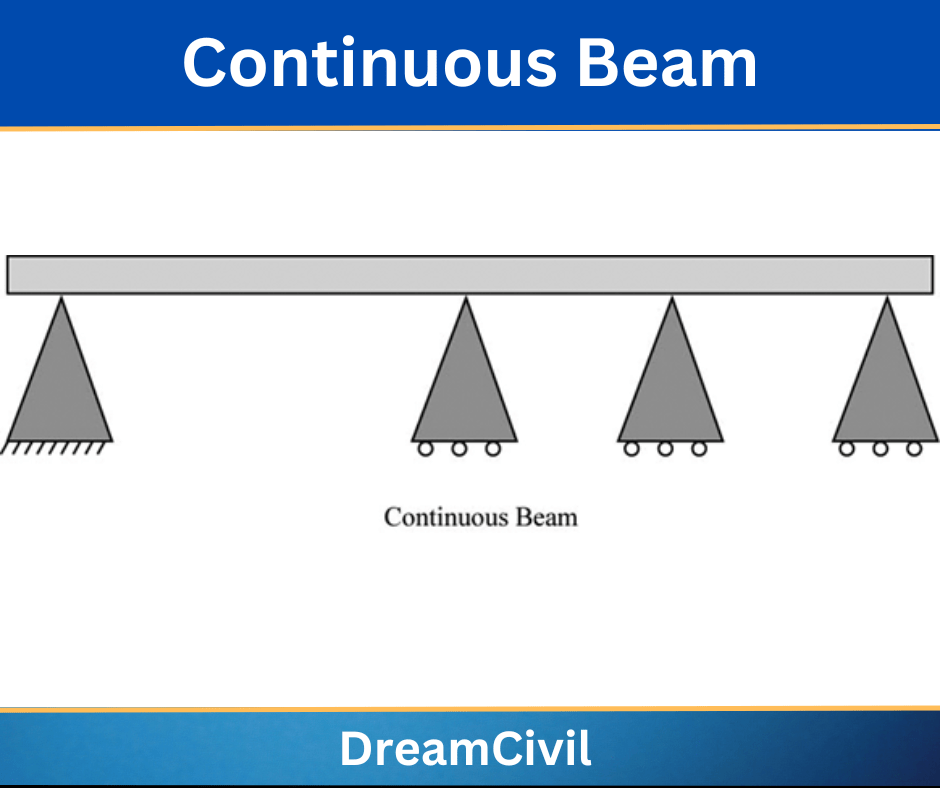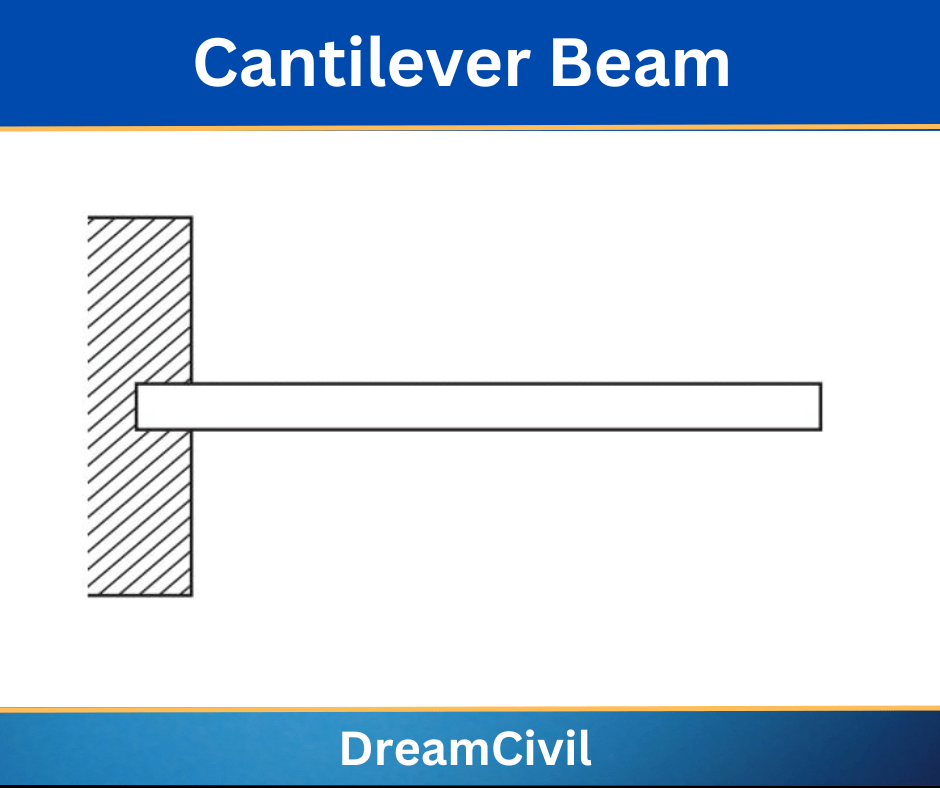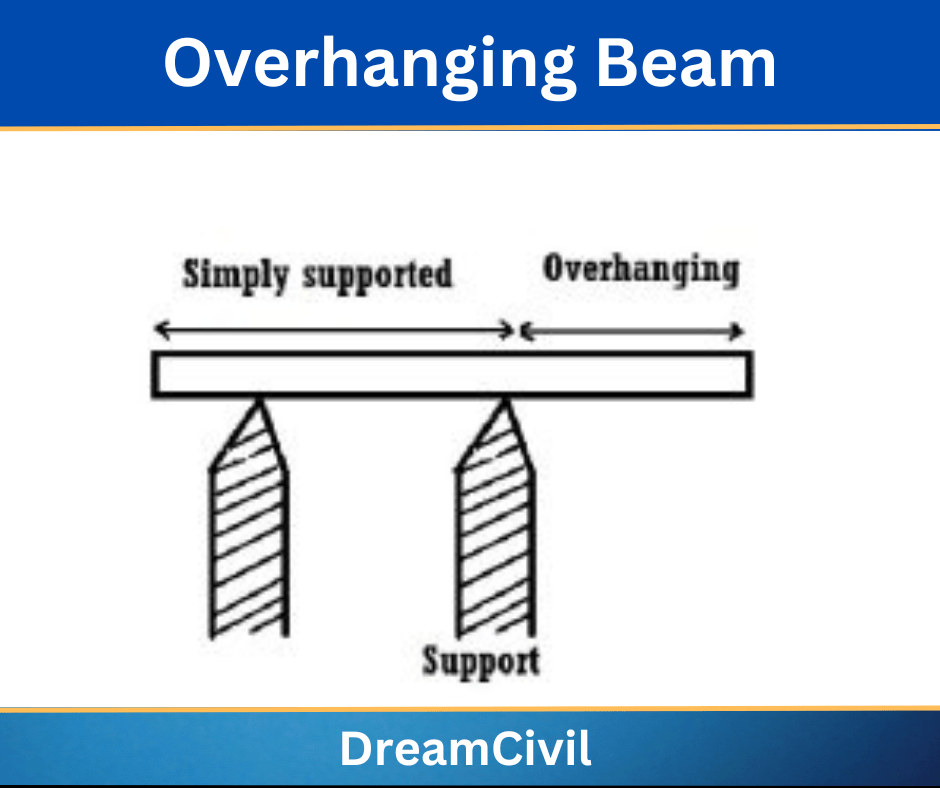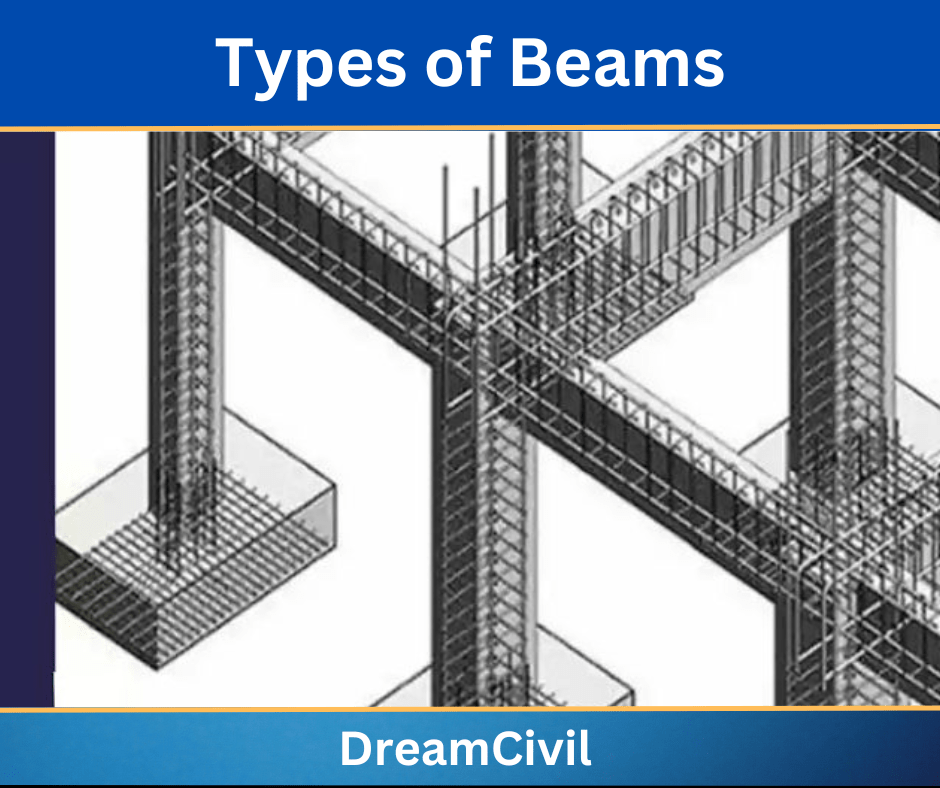Table of Contents
The beam is a horizontal structural element made up of wood, steel, or concrete that resists the lateral loads coming from the superstructure by means of bending.
It is expected to withstand shear force, lateral force, and bending moments.
The beam when loaded with forces gets transferred to the foundation through the support reaction.
1. Types of beams
The types of beams are classified in many ways depending on various factors;
A. Based on the Type of Supports
I. Simply supported beam
It is a type of beam in which support provided at each end is free to rotate. The support provided is pin support at one end and roller support at another end.
For example; Beam resting on a brick wall without end restraints.

II. Continuous beam
It is a type of beam that rests on more than 2 points of support along its length. It is stiffer and strong than simply a supported beam.
For example; a long-span bridge

iii. Cantilever beam
It is the type of beam in which one end is fixed and the other is a free end. The free end portion is subjected to vertical load.
For example; balcony protruding, car park, etc.

iv. Overhanging beam

a. Single overhanging Beam
It is a simple type of beam in which a certain portion of the beam is extended beyond the support only at one end. It is the merge of simply supported and cantilever beams.
b. Double overhanging Beam
The type of beam in which the portion of the beam is extended on both ends of the beam is known as a double overhanging beam. The load applied on the hanging portion is safely transferred to the support (i.e. hinge or roller) by equivalent bending moment.
For example; a balcony that is being extended from the framed structure.
v. Fixed beam (Built-in Beam)
The beam in which both ends are fixed due to which the end slope becomes zero is known as a fixed beam. In this beam vertical movement or rotation of the beam is restricted and no bending moment is produced.
For Example; trusses

vii. Beam on the spring support
viii. Beam on elastic foundation
B. Based on the Equilibrium Condition
i. Statically Determinate
It can be determined by using basic statics equations only. An equilibrium condition is enough to analyze the structure. The bending moment and shear force produce at any section are independent of the cross-section, moment of inertia, or property of the material used.
For example; simply supported beam, cantilever beam, etc.
ii. Statically Indeterminate
It needs an extra equation or other material property like deformation for its analysis. The condition of equilibrium is not enough to determine the structure. The bending moment and shear force developed are dependent on the cross-section, the moment of inertia, and the property of the material used.
For example; Fixed-beam, continuous beam, etc.
C. Based on the Cross Section’s Shape
a. I- Beam
I-beam is a type of beam having a cross-section I-shaped. The 2 horizontal members are known as Flanges and the vertical member connecting the flanges is known as the “web” where the web and flange resist shear force and bending moment respectively.
b. T- Beam
The beam in which the slab and beam are cast monolithically has a cross-section T- shaped. The horizontal portion is a” flange” that resists compressive stresses and the vertical portion is known as a “web” and resists shear force and separation for the coupled force of bending.
It has no bottom flange that contributes to a tensile force but it can be productively used when inverted where the slab portion will act as the compressive flange.
c. C- Beam
The beam has a crosssection as C- shape in which the top and bottom horizontal plates are known as “flanges “and the vertical plate connecting the flanges is called” web“.
It is used to hold bridge decks and other heavy gadgets, purlins, wall beams of steel structures, etc.
d. H- Beam
This beam is similar to I-beam but its flanges and web width are the same which is made up of rolled steel joist. It is considered economical and has a greater strength-to-weight ratio.
e. Circular Beam
This beam is subjected to torsional moments along with shear force and bending moment which causes overturning if its end supports are not restrained.
It is not capable to bear loads and fails to transfer the load due to very little point of contact with the slab and column.
It is used in curved balconies, circular reservoirs, etc.
f. Square Beam/Rectangular Beam
A rectangular beam can carry a great load with a thin width than a square beam because beam strength varies in the cubic magnitude of depth.
A square beam has good torsional properties than a corresponding rectangular section.
g. Tapered Beam
This beam has a smaller cross-section at one end as compared to the support end.
D. Based on Material Used for Construction
a. Composite Beam
The type of beam is composed of 2 or more different materials in order to increase the strength and stiffness and to tackle weathering action.
For Example; RCC ( concrete and reinforcement )
b. Steel Beam
The beam that is composed of steel as I beam, plate girder, trussed beam, etc
c. Timber beam
A beam that is made up of dressed wood is known as a timber beam. Oka timber is considered good for the construction of beams.
E. Based on the Method of Construction
a. Precast Concrete Beam
The beam in which elements are manufactured in the plant under a suitable environmental condition with proper curing and transporting to the required position safely and casting is known as a precast concrete beam.
b. Cast In-situ Concrete Beam
The beam which is cast in the site in open surrounding in the actual position and curing in a site is known as a cast in situ beam.
Its maintenance cost is low and provides resistance to earthquake and wind load compared to precast beams.
c. Prestressed concrete Beam
The structural material is stressed before casting so it can counteract the forces when subjected to loading.
Generally, the steel reinforcement is subjected to loading in the beam but in a prestressed beam, the load is counteracted firstly by induced stresses throughout the beam.
F. Based on the Geometry
a. Straight Beam
The beam that has a straight profile along its length and is subjected to only bending moment and shear force is called a straight beam. The neutral axis of the beam coincides with the centroidal axis.
b. Curved Beam
This type of beam has a curved profile along its length and is subjected to bending moment, shear force, and torsional moment. The neutral axis lies between the centroidal axis and the center of curvature.
c. Tapered Beam
This beam has a smaller cross-section at one end as compared to the support portion.
This was for the types of beams.
2. FAQs
1. What are the different types of load that can act in the beam in the strength of the material?
⇒ The types of load acting on the beam are
a.Point load or concentrated load
b. Uniformly distributed load
c.Uniformly varying load
2. What are the different kinds of support on the beam?
⇒ The types of support on the beam are;
a. Fixed support
b. Pinned support
c. Fixed support
d. Simple support
3. References1. Content Filter & Authenticity Checking Team, Dream Civil International (Our team checks every content & detail to maintain quality.) |
Read More: Lap Length

